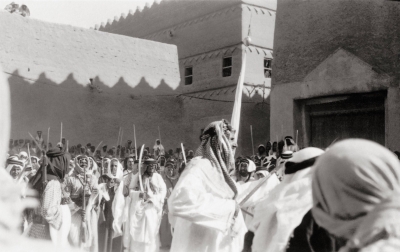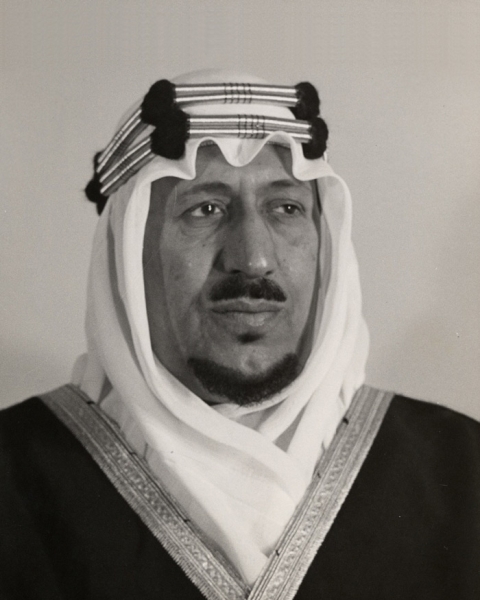
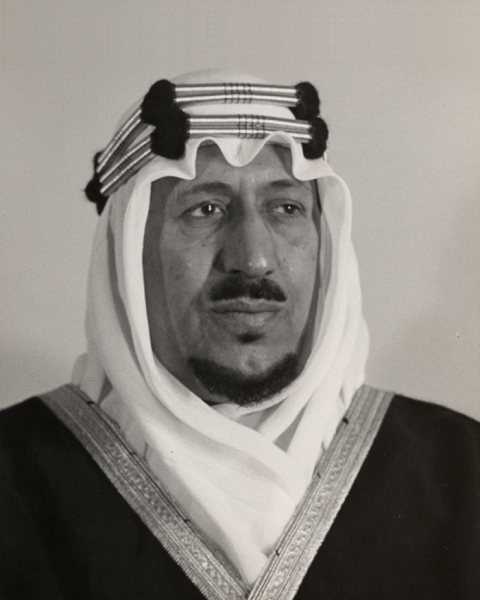
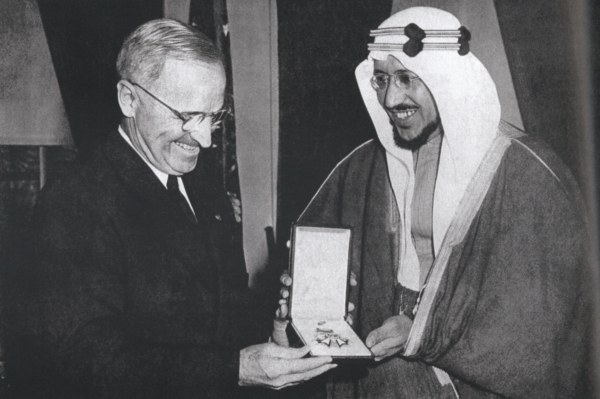
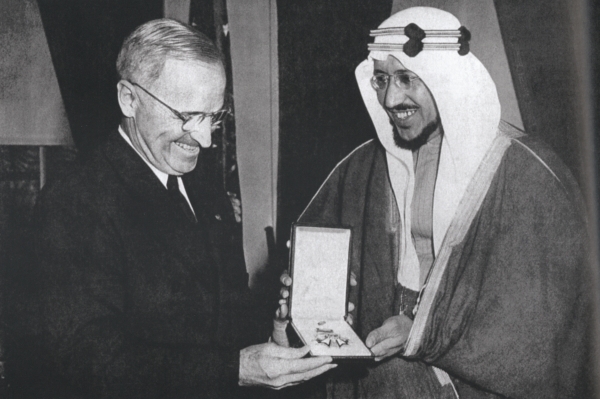
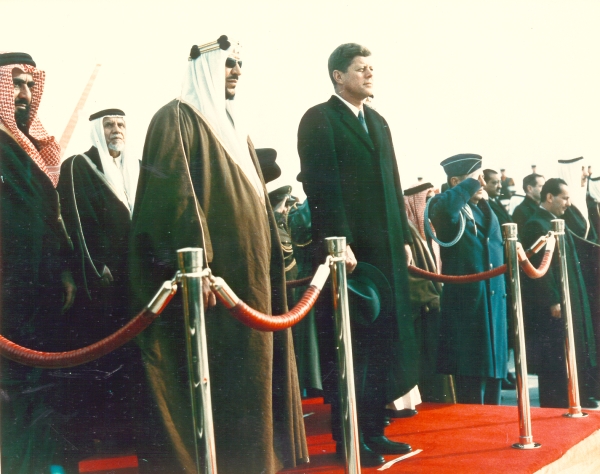
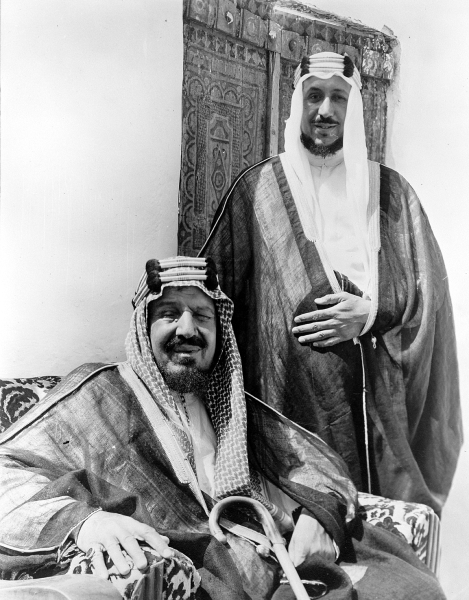
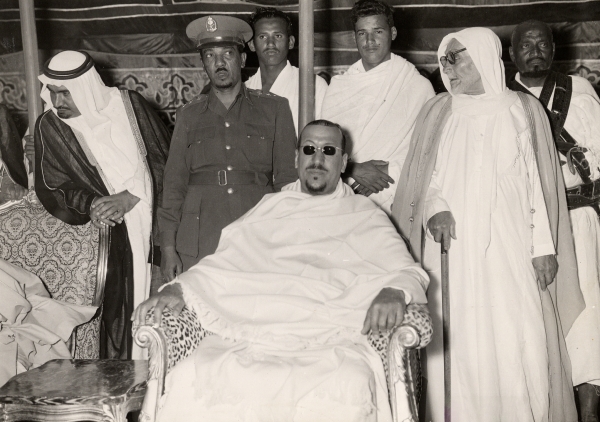
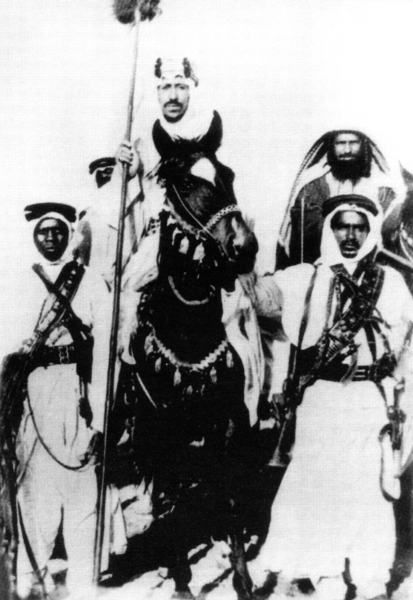
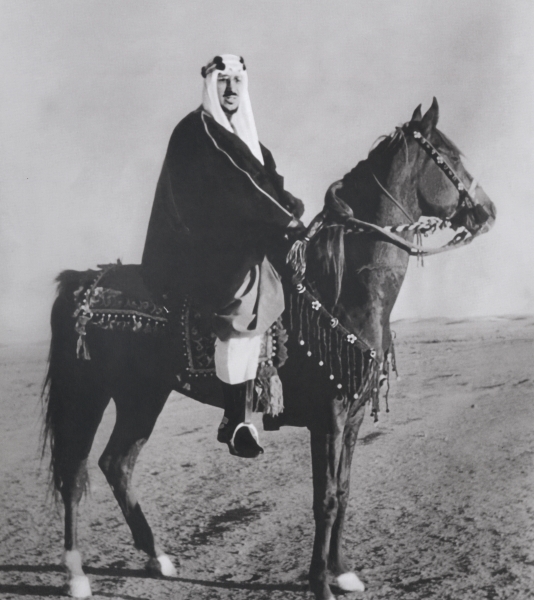
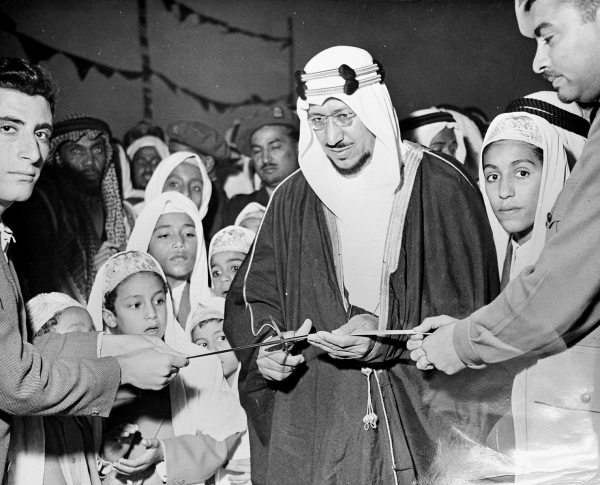
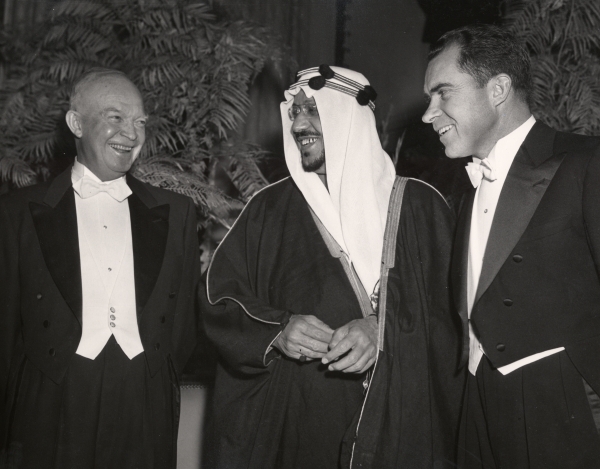
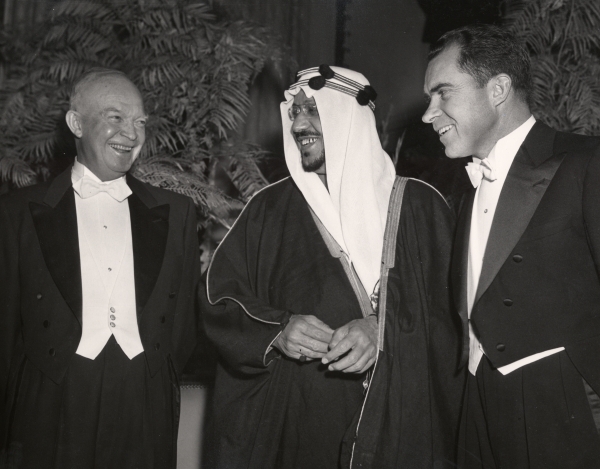
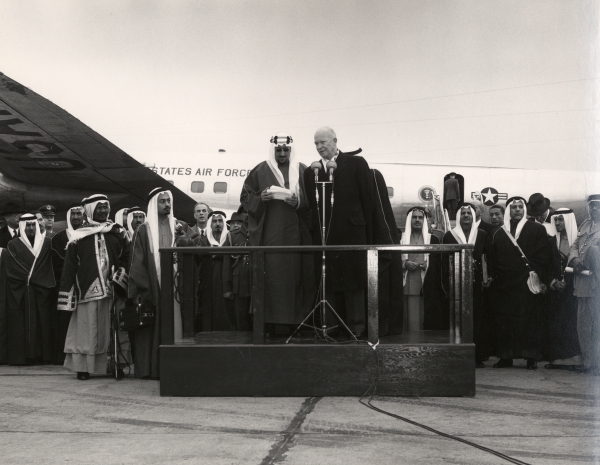

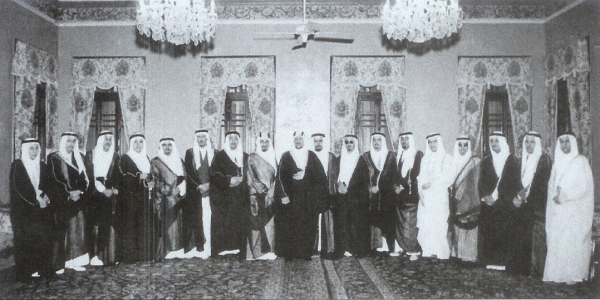
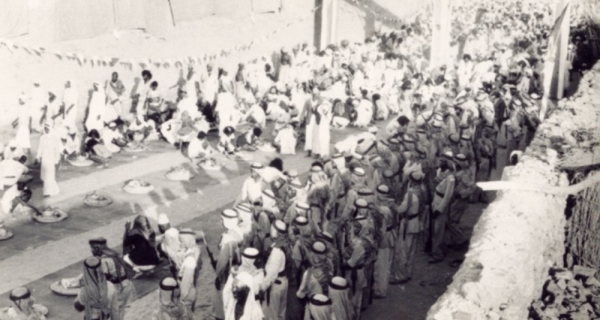
King Saud Bin Abdulaziz Al Saud (1902-1969) was the second king of the Kingdom of Saudi Arabia and the first crown prince in the history of the Saudi state. He was the first to assume the rule after the passing of the Founding King Abdulaziz Bin Abdulrahman Al Saud. Born in Kuwait, he passed away at his residence in Athens, Greece. His body was transported to Makkah al-Mukarramah, where funeral prayers were held at the Grand Mosque, and he was buried to rest in al-Oud Cemetery in Riyadh.
He ruled Saudi Arabia for eleven years, beginning after the death of his father, King Abdulaziz, on Monday, November 9, 1953, and his reign concluded on November 2, 1964. His period of rule ended with pledging allegiance to his brother and Crown Prince, Faisal Bin Abdulaziz, who became the king of the country following Saud's abdication and based on the consensus of the royal family.
The early life of King Saud Bin Abdulaziz
Lineage of King Saud
He is Saud Bin Abdulaziz Bin Abdulrahman Bin Faisal Bin Turki Bin Abdullah Bin Mohammed Bin Saud Bin Mohammed Bin Muqrin Bin Markhan Bin Ibrahim Bin Musa Bin Rabi'ah Bin Mani' al-Muraydi from Banu Hanifah, from Bakr Bin Wail, from Rabi'ah Bin Nizar, from Ma'ad Bin Adnan.
He is the second son of King Abdulaziz Bin Abdulrahman Al Saud, his mother is Wadha Bint Mohammed Al Orair.
Birth and upbringing of King Saud
King Saud was born on January 15, 1902. His birth coincided with his father's recapture of Riyadh. King Saud spent his early childhood with his parents, siblings, his grandfather Imam Abdulrahman Bin Faisal, and his grandmother Sara Bint Ahmed al-Sudairi. The bond between Saud and his older brother Turki with their grandparents during their childhood significantly impacted their upbringing.
After the recapture of Riyadh by King Abdulaziz, he requested his father and family to join him. His wife, Wadha, and their children returned with Imam Abdulrahman, while the rest of the women joined King Abdulaziz after the Battle of Dilam in 1903. When King Saud reached the age of five, his father, Abdulaziz, entrusted his education to Sheikh Abdulrahman Bin Nasser Bin Mufarrij, one of the prominent Quranic reciters and scholars at that time. Sheikh Abdulrahman was teaching at 'Mufarrig School,' the largest Quranic school in Riyadh City. King Abdulaziz enrolled Saud in the school, where he studied to gain knowledge in religion, jurisprudence (fiqh), hadith, and interpretation. He completed the memorization of the Quran at the age of eleven under Sheikh Abdulrahman's guidance.
King Saud in his youth
The Founding King would bring Saud to his councils and those of his grandfather, Imam Abdulrahman, along with his brother Turki. As Saud grew older, he gained his father's trust by independently handling various military, political, and administrative tasks. King Abdulaziz delegated to Saud responsibilities that required political acumen in foreign affairs, as Saud had received education in political science and diplomacy under the guidance of King Abdulaziz and his advisers.
King Saud accompanied his father during his childhood and youth, forming a strong friendship between them that became truly exemplary, considering the close age proximity between them. At the time of his father's death, he told mourners, 'I have lost my father and my friend.' His close relationship with his grandfather, who raised and mentored him and remained under his guidance until his death, instilled in him the customs and traditions of the tribes and Bedouin, and how to deal with them. He mastered skills in archery, hunting, and horsemanship, and developed a penchant for the Bedouin lifestyle from an early age. He accompanied his father and other senior leaders in invasions, witnessing the arts of warfare and planning battles. He quickly rose to become one of his father, King Abdulaziz's senior aides, during political circumstances when King Abdulaziz direly required individuals of his caliber.
Personality and qualities of King Saud
King Saud closely resembled his father, according to resources. He stood at a height of 2.04 m, while King Abdulaziz was 2.07 m tall. King Saud inherited many characteristics from his father, such as his strong build, smile, imposing presence, and various dignified qualities. He shared his father's integrity, generosity, and love for honesty. His powerful and resonant voice had a significant impact on the battles he participated in, and those who fought alongside him noted that King Saud possessed a commanding voice that influenced those who heard it. He memorized numerous war poems and chants, which he would recite during wartime, instilling enthusiasm and confidence. Known for his leniency, he remained firm and resolute in challenging situations. King Saud was a man of few words, preferring to listen more than to speak.
King Saud dedicated specific times for reading the Quran and religious lessons, as well as times for addressing governance and administrative matters. He had a passion for equestrianism and hunting. Additionally, he personally cared for the flowers in the gardens of his palaces, which positively influenced his interest in the agricultural aspects across various regions of Saudi Arabia.
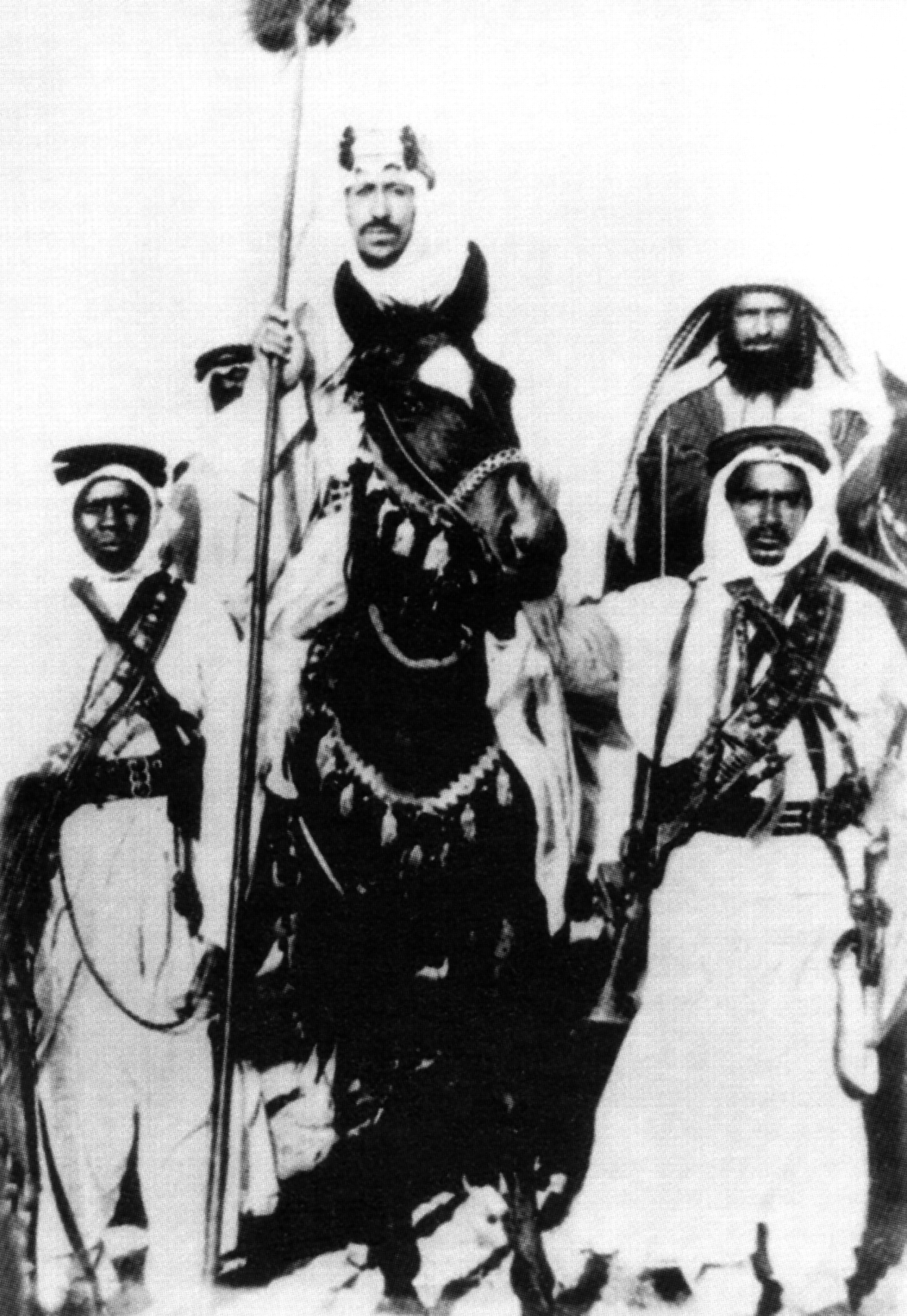
King Saud assumed political duties
Early responsibilities and mandates
At the age of thirteen, King Abdulaziz entrusted his son King Saud with his first military responsibilities, recognizing his competence, capability, and worthiness for political and military tasks. One of his initial assignments was a political mission to Qatar on behalf of his father in 1915. In the same year, he participated with his brother Prince Turki in the Battle of 'Jarrab' near az-Zulfi Governorate. His involvement in this battle was a crucial point in his life, as it provided him with lessons in war management, combat arts, strategic planning, and political strategies in negotiating agreements. He also accompanied his father in the Battle of 'Abu Layla' near al-Ahsa. After a year, in 1917, he joined his brother Prince Turki in the 'Battle of Yatib'.
Battle of Turbah
King Abdulaziz noticed the military capabilities and diplomatic skills of his son Saud with tribes, so he appointed him to lead an independent army for the first time after the Battle of Turbah in 1918. This battle was against the forces of Sharif Hussein in Hejaz and was significant as it paved the way for King Abdulaziz to enter Hejaz. Following the Battle of Turbah, King Saud proceeded to discipline the rebels who were loyal to Sharif Makkah, King Hussein Bin Ali. This took place at a location called Sharmah near the wells of Dafinah. Accompanying him on this expedition were Ibn Rabi'an, Ibn Muheia, and others from the prominent Otaibah tribe. Also accompanying him was Sharif Khalid Bin Mansour Bin Luay. King Saud achieved victory over them in the wells of Dafinah at the end of Ramadan 1919. After their dispersal, he pursued them for the second time between Hejaz and Najd, capturing a significant number of their leaders before returning to Riyadh, preceded by news of his victories.
Commanding forces in Hail
King Abdulaziz sent his son Saud at the head of a large force to the south of Mount Aja in Hail. The attack against Al Rashid commenced, yielding numerous spoils. However, further progress was hindered due to severe drought in the region that year. King Abdulaziz ordered a detachment to be sent near Buqayq, while he advanced himself towards al-Ajfar. Since they did not engage in battle, the forces withdrew and returned to Riyadh in 1919. In the summer of 1921, King Abdulaziz returned to attack Hail with around ten thousand fighters. He devised a plan to encircle Hail from three directions, assigning the leadership of one detachment to his brother Mohammed to besiege Hail. Another was led by his son Saud to attack directly, while he retained the third detachment under his command in Qassim as a reserve force.
Prince Saud, along with his companions, attacked the outskirts of Hail and descended upon the village of al-Khasirah to the east of Hail, where they achieved victory. Meanwhile, his uncle, Mohammed, headed towards the outskirts of Hail. Faisal al-Duwaish was assigned to launch an attack from the south. King Abdulaziz then decided to summon his brother Mohammed and hand over the overall command to his son Saud, who besieged Hail, tightening the noose around it for two months. The severity of the blockade did not wane until Abdullah Bin Mutaib al-Rashid initiated steps towards reconciliation. Subsequently, he surrendered to the forces of King Saud. In this situation, the chivalry, valor, and noble conduct of Prince Saud became apparent. He welcomed the surrender of his opponent, receiving him with the respect befitting a ruler and a guest. He personally accompanied him to Riyadh to present him to his father, leaving a profound impact on Ibn al-Rashid and those interested in reconciliation and peace.
The situation did not last long as the Governor of Hail, Mohammed Bin Talal Al Rashid, reverted to rebellion. King Abdulaziz ordered his son Saud to return to Hail and lead the army there. Saud's role was to support the stationed forces. He headed to Hail, achieved victory, and forced Al Rashid forces to retreat. This coincided with the arrival of Saudi forces, putting pressure on them by launching attacks from the north and northeast under the leadership of King Abdulaziz. Meanwhile, Saud's forces remained on the outskirts of Mount Aja. Together, these forces represented a triumph, marking the second surrender of Hail to the Saudi forces. When the surrendering parties came to greet King Abdulaziz, he directed them to his son Saud's tent to greet him. Subsequently, Hail was incorporated into the Saudi rule.
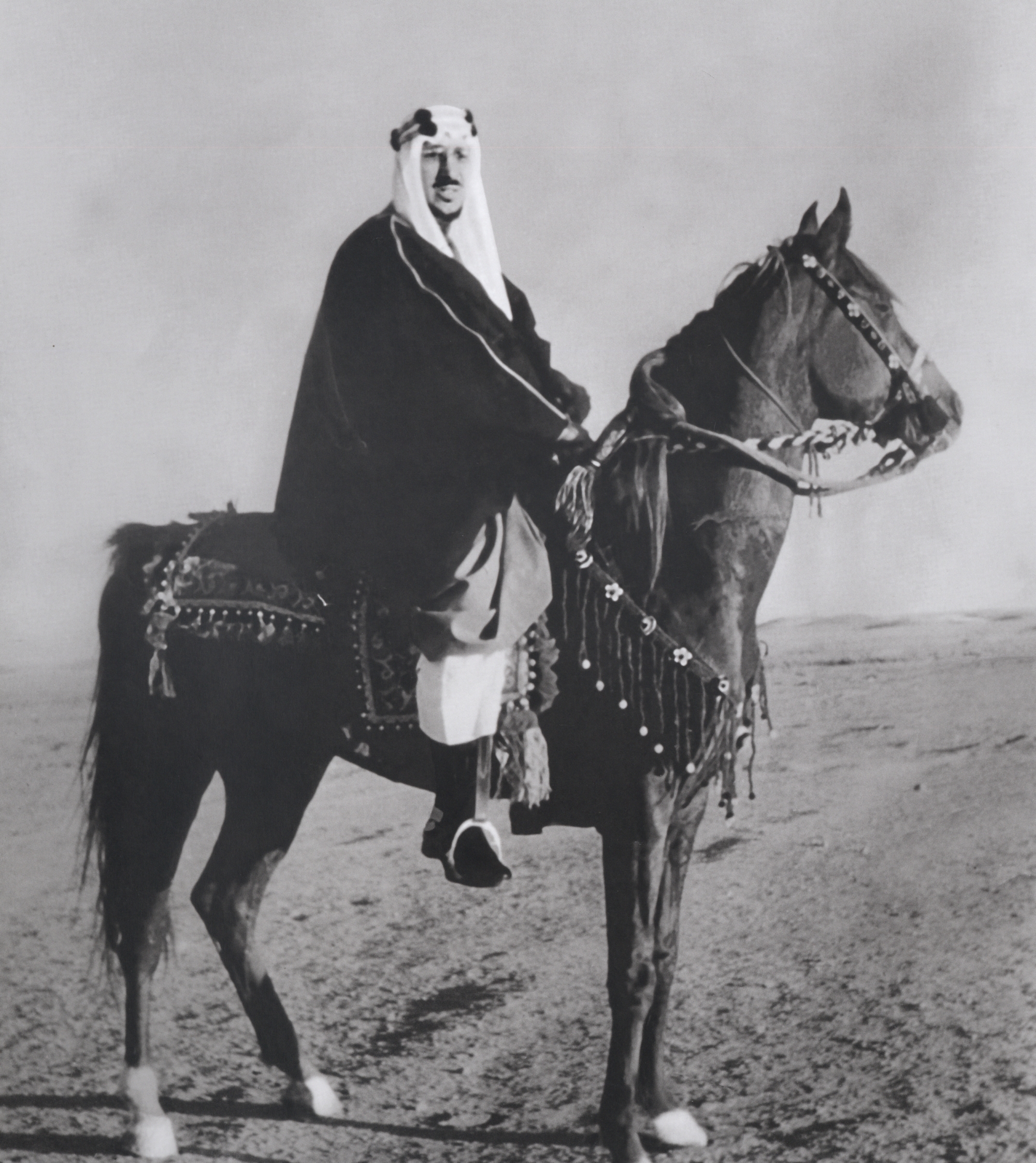
Annexation of Hejaz cities
After King Abdulaziz's forces entered Makkah al-Mukarramah, King Abdulaziz visited the city for the first time as a pilgrim. He left his son Saud in Riyadh to manage the governance under the supervision of his grandfather, Imam Abdulrahman, who was highly respected and valued by Saud. Saud continued as his father's deputy in Riyadh until King Abdulaziz gained control over the city of Jeddah. Subsequently, King Abdulaziz sent his son Saud along with Khalid Bin Lu'ay and a military force consisting of seven battalions to the regions around Yanbu. Saud succeeded in annexing these areas on January 10, 1926.
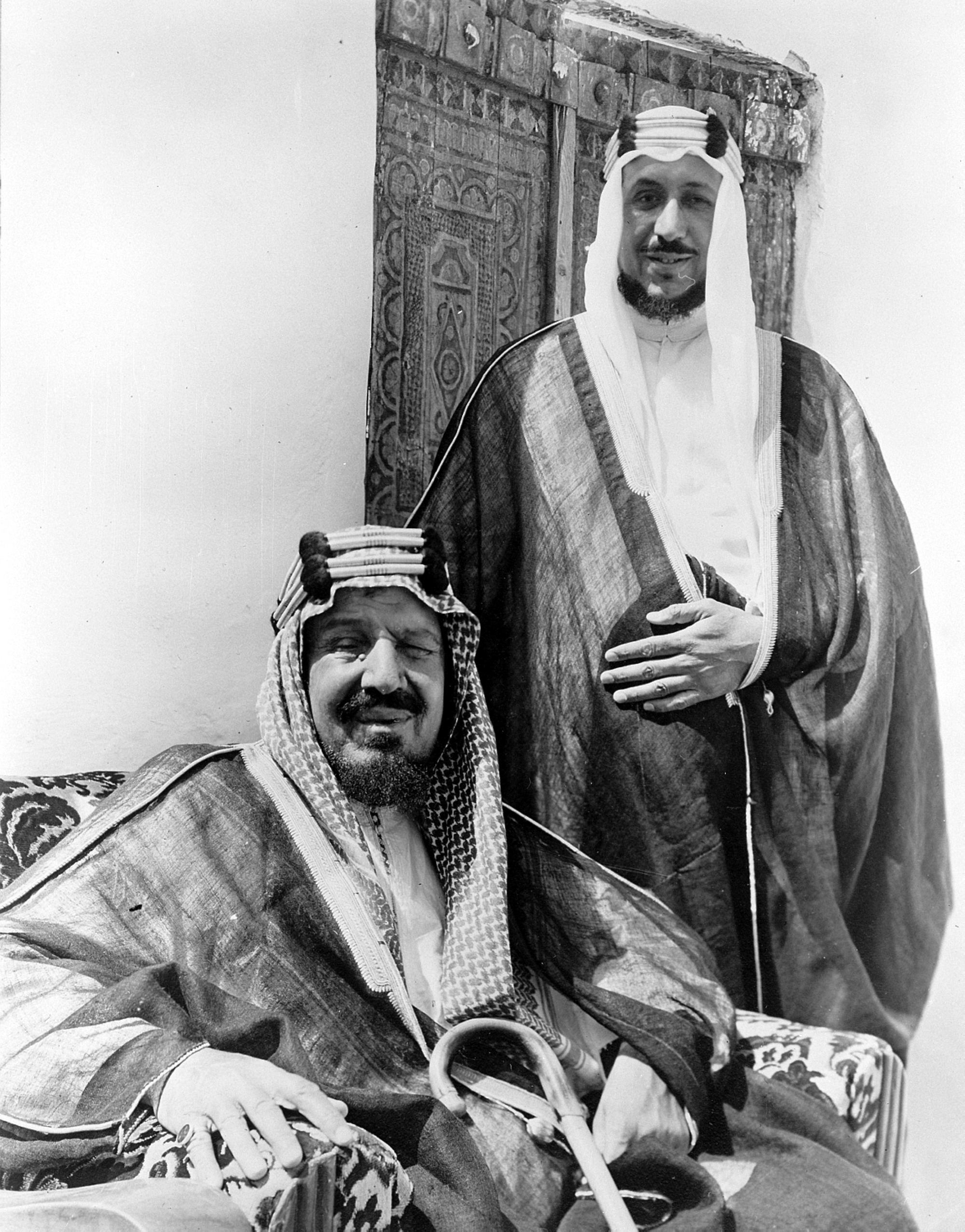
King Saud Bin Abdulaziz, the statesman
Crown prince designation
After unifying the parts of Saudi Arabia, King Abdulaziz decided to name the unified territories 'The Kingdom of Saudi Arabia', announcing this on September 22, 1932. Following this, he prepared to declare his son Saud as the Crown Prince, having fulfilled all the required Sharia qualifications after his proven leadership role and ability to handle events. Saud was deemed worthy to be his official successor to take over when necessary, continuing his effort and struggle to unify the nation and advance it according to the path and plan laid out by him. He was nominated for the crown prince position and unanimously endorsed. King Abdulaziz issued a Royal Decree approving the decision of the Shura Council and the Council of Agents on May 11, 1933, appointing him as the crown prince. All family members, dignitaries of Saudi Arabia's regions, and tribal leaders pledged their allegiance to Prince Saud as the crown prince. At that time, Prince Saud was in Riyadh, and the allegiance ceremony took place in the Grand Mosque.
King Saud remained in the position of crown prince for twenty years, a period that coincided with the unification of Saudi Arabia and the beginning of a new foundational, economic, and social era, particularly with the discovery of oil in 1932. Saudi Arabia started relying on oil, as its economy was going through a challenging phase with scarce resources, dependence on foreign aid, and revenues from Hajj. The new transition enabled the state to initiate administrative and financial reforms, leading to a gradual transition into a modern state. This imposed a new reality on the inhabitants of the Arabian Peninsula.
Diplomatic visits
After appointing Prince Saud as the crown prince and his visit to Egypt, King Abdulaziz saw the opportunity to allow his son Saud to travel abroad and become acquainted with the conditions of friendly countries dealing with him. King Abdulaziz encouraged his son to travel to Europe and prepared a comprehensive program for visiting several countries, including Italy, France, England, and some Arab nations. After concluding the European journey, Prince Saud continued his travels to the Arab world through Alexandria, heading to Jerusalem and East Jordan in 1935. He returned to Jeddah from there, accompanied by a delegation including Fouad Hamza and Dr. Medhat Sheikh al-Ard. His reception in Palestine was warm, and he performed prayers at al-Aqsa Mosque and the Ibrahimi Mosque in Hebron, becoming the first Saudi prince to visit Jerusalem.
In 1936, Saudi Arabia signed a Treaty of Arab Brotherhood and Alliance with Iraq, opening avenues for strengthening diplomatic relations and establishing military ties. This treaty also encouraged other Arab countries to join. Prior to this, a similar treaty was signed with Yemen in 1934. In 1936, to enhance understanding and implementation, Prince Saud visited Iraq at the invitation of King Ghazi. This visit yielded positive results in strengthening the overall relationship between the two countries. Additionally, Saudi Arabia signed another treaty with Egypt, through which Egypt officially recognized Saudi Arabia. Following this, the Saudi government began sending its students and pilots to Egypt for education and training.
Prince Saud visited Bahrain on December 15, 1937, with the aim of improving the strained relations between Bahrain and Qatar due to border issues. In 1937, King Abdulaziz delegated him to represent him in the celebrations for the coronation of King George VI in Britain. During this period, he met with various Arab and foreign leaders, marking the beginning of strong friendships with many of them. He took advantage of his presence there to discuss various bilateral and Arab issues. This was followed by another private visit to Britain in 1938 with his brother Mohammed, where he stayed for a month, followed by additional visits to the Gulf Emirates until the beginning of World War II in 1939-1945.
Managing the affairs of the country on behalf of his father
In an enhancement of the status and position of Crown Prince Saud in the eyes of the people as the heir apparent and the second man in the state, King Abdulaziz issued a decree in 1939 that all correspondences and files be presented to Prince Saud. In the same year, Saud was appointed as the Deputy Commander-in-Chief of the Saudi forces. In 1947, Prince Saud was assigned the responsibility of overseeing the Hajj and delivered the annual sermon after completing the Hajj rituals. In his speech, he expressed his father's appreciation for the demands of the pilgrims and the residents of the region. He also announced the state's determination to implement the project to construct a paved road between Jeddah and al-Madinah al-Munawwarah.
During that period, Prince Saud inaugurated the project to supply water from Wadi Fatimah to the city of Jeddah. In 1950, he opened the College of Sharia, which later became the nucleus of Umm al-Qura University. The Teachers' College was established in 1952, followed by the College of Sharia in Riyadh in 1953. While in Hejaz, Prince Saud sought permission from his father to return to Riyadh after completing the Hajj rituals. Still, King Abdulaziz asked him to stay in Hejaz to conduct a study on the administrative situation and propose reforms needed there until he completed his mission.
Commander-in-Chief of the Armed Forces and Internal Security Forces
On August 25, 1953, King Abdulaziz appointed Prince Saud as the Commander-in-Chief of the Armed Forces and Internal Security Forces. This strengthened his position as the second man in terms of authority and powers in the state. The Saudi land military and airforce were modernized both by providing them with weapons and training from American experts on the latest war tactics. This was aimed at ensuring that the Saudi forces were capable of fulfilling their national duties. Additionally, there was an expansion of the Saudi Arabian Airlines fleet through the purchase of four 'Skymaster' aircraft. New flights were organized within the country and to neighboring Arab countries to transport pilgrims.
Internal reforms
Prince Saud visited al-Madinah al-Munawwarah and signed a series of decrees to build new roads, schools, and hospitals. He laid the foundation stone for the expansion of the Prophet's Mosque on June 17, 1953. His father, Founder King Abdulaziz, assigned him the responsibility of overseeing this expansion, and he continued to monitor the progress until its official inauguration in 1956.
King Saud directed efforts towards the establishment and expansion of mosques. He also established Sharia courts. Due to his interest in education and encouragement of knowledge, he appointed a new deputy for the Directorate of Knowledge. He ordered the establishment of a group of new schools in several desert regions and requested assistance from some of the Arab countries to seek experts' advice in various fields, such as, municipal, economic, and agricultural affairs, as well as civil security and health affairs, and the establishment of a Saudi industrial institute. In that year, King Abdulaziz suffered a health setback and decided to appoint Prince Saud as the head of the first Council of Ministers in Saudi Arabia. At that time, several ministries were established in the modern state on October 9, 1953.
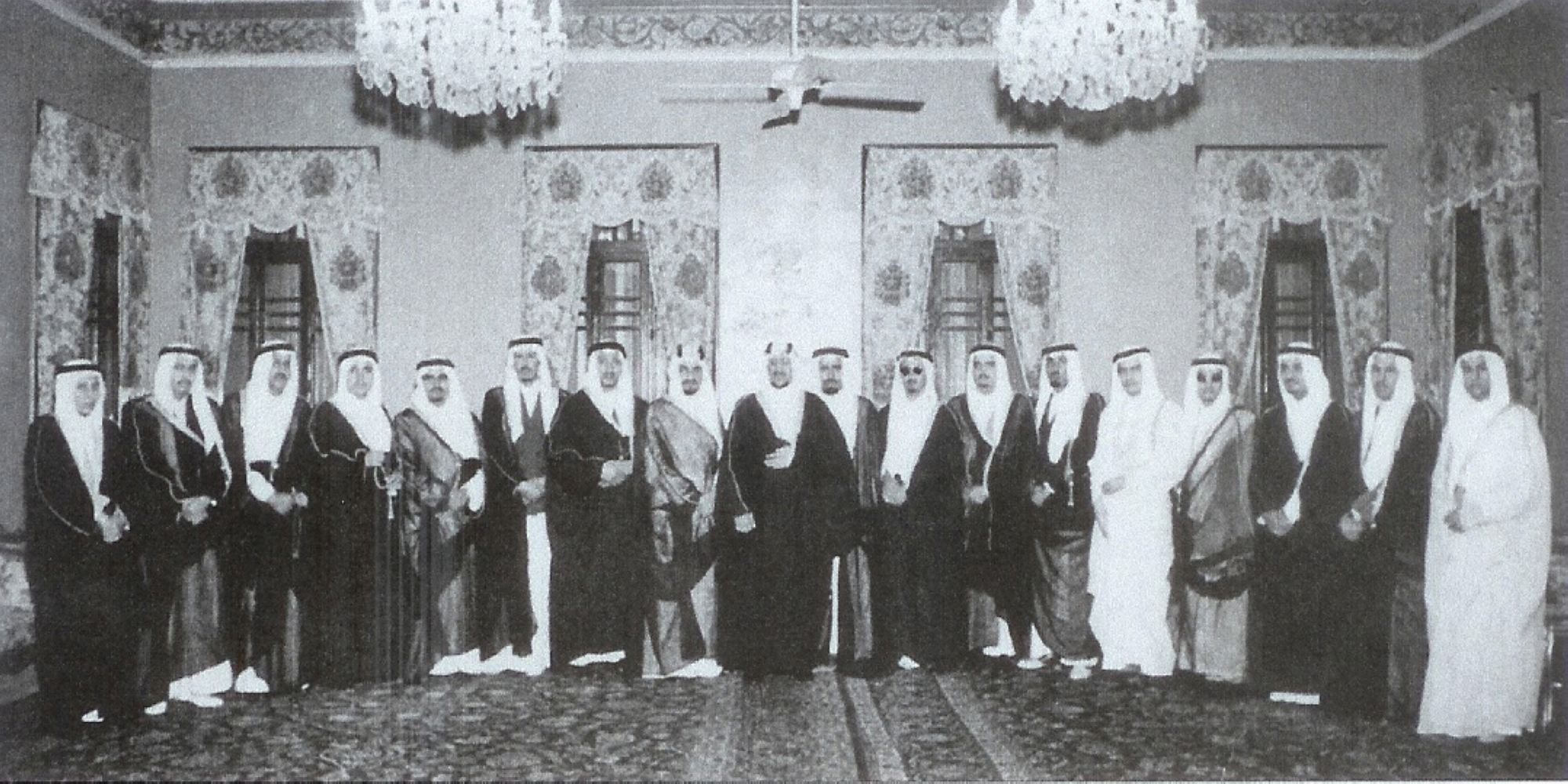
King Saud assumes the reins of governance
Allegiance of King Saud as king
After the death of the Founder King Abdulaziz Bin Abdulrahman Al Saud, on November 9, 1953, King Saud was pledged allegiance as the king of Saudi Arabia. King Saud received supporters on the afternoon of Wednesday, November 11, 1953, at the Royal Palace. Immediately upon assuming the rule, he announced the transfer of the crown prince position to his brother, King Faisal, and family members of the royal household pledged allegiance to him in this capacity.
King Saud assumed the reins of governance and visited several key cities, starting with Makkah al-Mukarramah, where he led worshipers at the Grand Mosque. He promised the residents to give the utmost care and attention to the blessed city. During his visit to al-Madinah al-Munawwarah, he led prayers at the Prophet’s Mosque and inspected the construction work at the Prophet's Mosque peace be upon him (PBUH). He participated in the transportation of stones and soil and the digging of the northwest minaret in front of everyone, reminiscent of the Prophet and his honorable companions, leaving a profound impact on the observers.
Before King Saud's return to Riyadh, he issued a Royal Statement on November 28, 1953. In the statement, he expressed his confidence in all the state's employees and extended gratitude for their contributions while reaffirming their positions. He expressed his desire to continue efforts for the country's development, aspiring to achieve glory, progress, and prosperity within the framework of the Quran, the Sunnah of the Prophet, and the gracious Sharia. King Saud emphasized the importance of implementing construction projects, beneficial works, spreading knowledge, and building military capabilities. He called on everyone to contribute to the governance responsibilities to the best of their abilities. Before leaving Hejaz, King Saud pledged to immediately execute several projects, including the expansion of the Two Holy Mosques, and the Holy Sites, building roads between them, and providing healthcare services. He gave significant attention to the capital, Riyadh, in terms of planning, modern construction, urban expansion, and development.
Regulating internal policy
King Saud retained the last ministerial formation of his father's era by adding several ministries on August 15, 1954. He appointed his brother and Crown Prince, Prince Faisal Bin Abdulaziz, as the head of the Council of Ministers—later to become King Faisal. King Saud, who personally focused on the Ministry of Knowledge (now known as the Ministry of Education), appointed his brother Prince Fahd Bin Abdulaziz as its first minister. He quadrupled the ministry's budget. He appointed Ahmed al-Sudairi as the Minister of Agriculture, Dr. Rashad Pharaon as the Minister of Health, and Mohammed Ali Reda as the Minister of Commerce and Industry in 1955. He also added a group of advisors to the Council of Ministers. He included two important departments within this ministry: the Department of Labor and Workers, and the Department of Broadcasting in 1955.
The new government laid the foundations for future development through a five-year plan for the first time in Saudi Arabia's history. In the same year, the Board of Grievances was established. He appointed his brother, Prince Sultan, as Minister of Transportation in 1955. King Saud began his reign by embarking on trips to various parts of Saudi Arabia to study their needs for projects and reforms and to listen to the desires of the residents. He started with the Eastern Province and its oil facilities, as well as the agricultural centers in al-Ahsa. He also visited the northern regions, including Hail, and the southern regions, including Aseer and Najran.
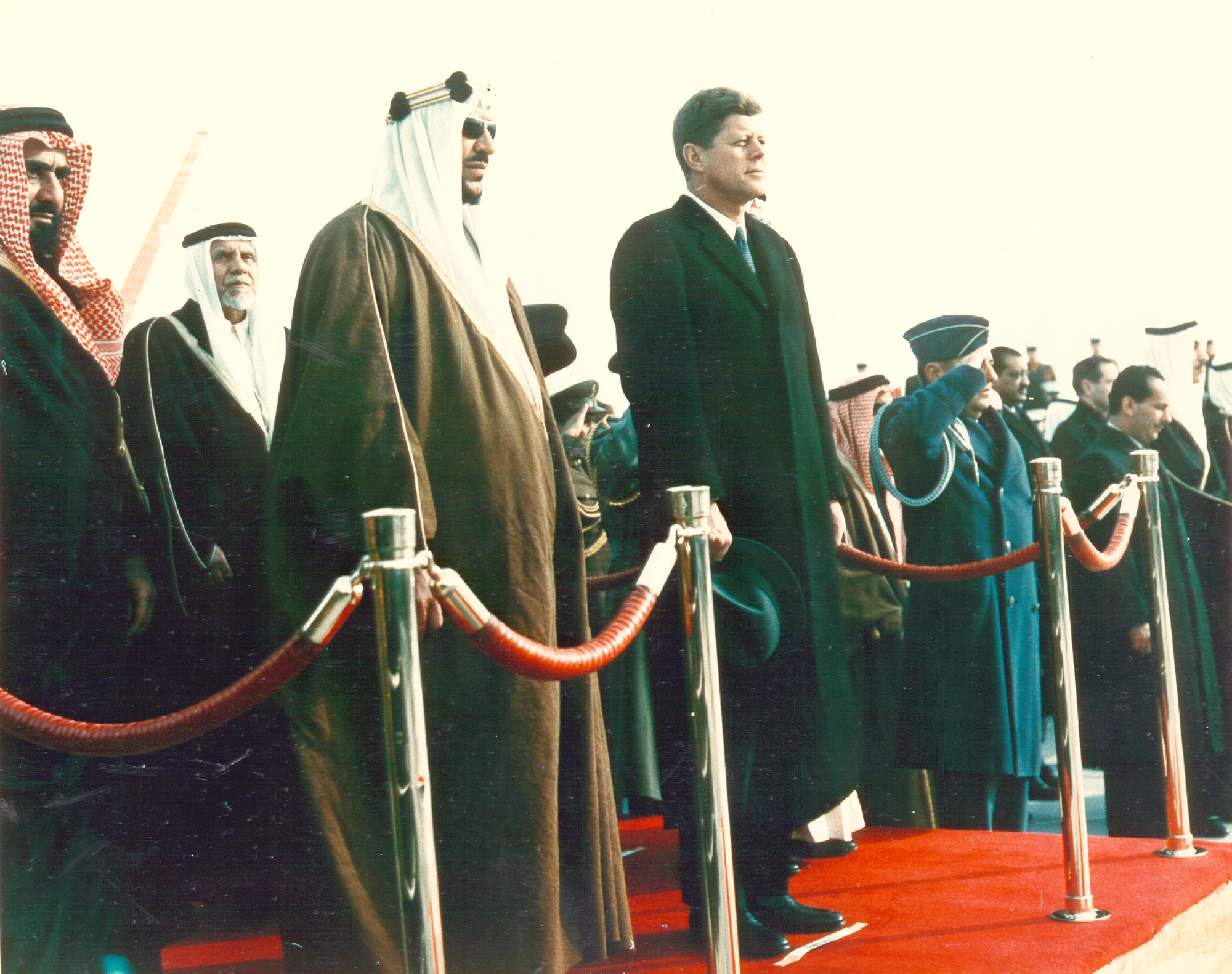
Defining Saudi foreign policy
King Saud adopted a foreign policy based on friendly relations with all countries, strengthening ties with Arab and Muslim allies, preserving security and peace, contributing to mitigating the dangers of wars, and preserving international relations through peaceful means. Saudi Arabia, under his leadership, maintained its strength and emerged as a powerful nation. This was the result of the legacy left by King Abdulaziz to his sons, who continued to build on it. Saudi Arabia played a crucial role in regional peace, establishing unprecedented regional stability over the past decades.
King Saud outlined the general lines of his foreign policy in his historic speech at the first meeting of the Council of Ministers. He affirmed his intention to follow in the footsteps of his father, King Abdulaziz, prioritizing the unification of the Arab voice, supporting their interests, and emphasizing the role of the Arab League and the comprehensive reform of its charter. He committed to rejecting any form of alliance policy for the sake of Arab unity and declared his support for all Arab liberation causes against colonialism, with particular emphasis on the Palestinian issue. He also expressed his determination to support the Arab cause and cooperate in any field possible to prevent aggression. One instance that highlighted his Arab policy was his stance on the Kuwait issue when Abdulkarim Qasim, the ruler of Iraq, attempted to annex it in 1961. King Saud stood by Kuwait and offered assistance
Development achievements during the rule of King Saud
Economic development in the country
King Saud issued orders to establish the Ministry of National Economy, incorporating it into the Ministry of Finance with its headquarters in Jeddah. Before this arrangement, an order was issued to form an Economic Council, but this council did not convene until it was reconstituted with members from the Ministries of Finance and Economy, as well as the president of the chambers of commerce in Makkah and Jeddah. A new law for this council was issued on April 26, 1954.
On September 3, 1954, King Saud issued a Royal Decree to merge the Ministry of National Economy and the Ministry of Finance. Sheikh Mohammed Suroor al-Sabban was appointed as the Minister of Finance and National Economy. Additionally, the Ministry of Commerce was established by Royal Decree on March 15, 1954. The Industrial and Electricity Affairs Administration was also established, focusing not only on operating electricity but also on establishing industries to achieve self-sufficiency in operation and maintenance.
Due to the significant impact of oil wealth as a clear vital source for economic development, and recognizing the large reserves possessed by Saudi Arabia, King Saud ordered the continued exploration and drilling for oil in the territories of Saudi Arabia, especially in the Eastern Province. Eight new oil fields were discovered as a result of these efforts. Subsequently, King Saud instructed the establishment of a national institution for oil and minerals known as the 'General Petroleum and Mineral Organization.' One of its main objectives was to contribute to various aspects of commercial and industrial activities related to petroleum and minerals.
One of King Saud's most notable accomplishments was securing a share in the profits of the Trans-Arabian Pipeline, 'Tapline,' an administratively independent company, affiliated with Aramco and owned by the four companies that own Aramco. Despite attaining half the shares, alongside increases in taxes and royalties, King Saud was determined to introduce the principle of participation in the ownership of Aramco. The first adoption of the idea of participation in the ownership of Aramco occurred in 1963. King Saud's efforts culminated in complete ownership, marked by the establishment of a dedicated Ministry of Petroleum, emphasizing its independence similar to other ministries. This demonstrated his commitment to the establishment of the Ministry of Petroleum and Mineral Resources.
Recognizing the importance of currency as a key element in economic development, King Saud worked to improve the state of Saudi currency after the establishment of the Saudi Arabian Monetary Authority (SAMA) on October 3, 1952, towards the end of King Abdulaziz's reign. This had a significant impact on the flourishing of economic activity, particularly cash exchange in major markets dealing with Saudi Arabia. King Saud's role was pivotal considering the status of the monetary system in place before the opening of SAMA, as various foreign currencies were widely circulated among the public, in addition to the official currency. This led him to introduce the first paper currency in Saudi Arabia.
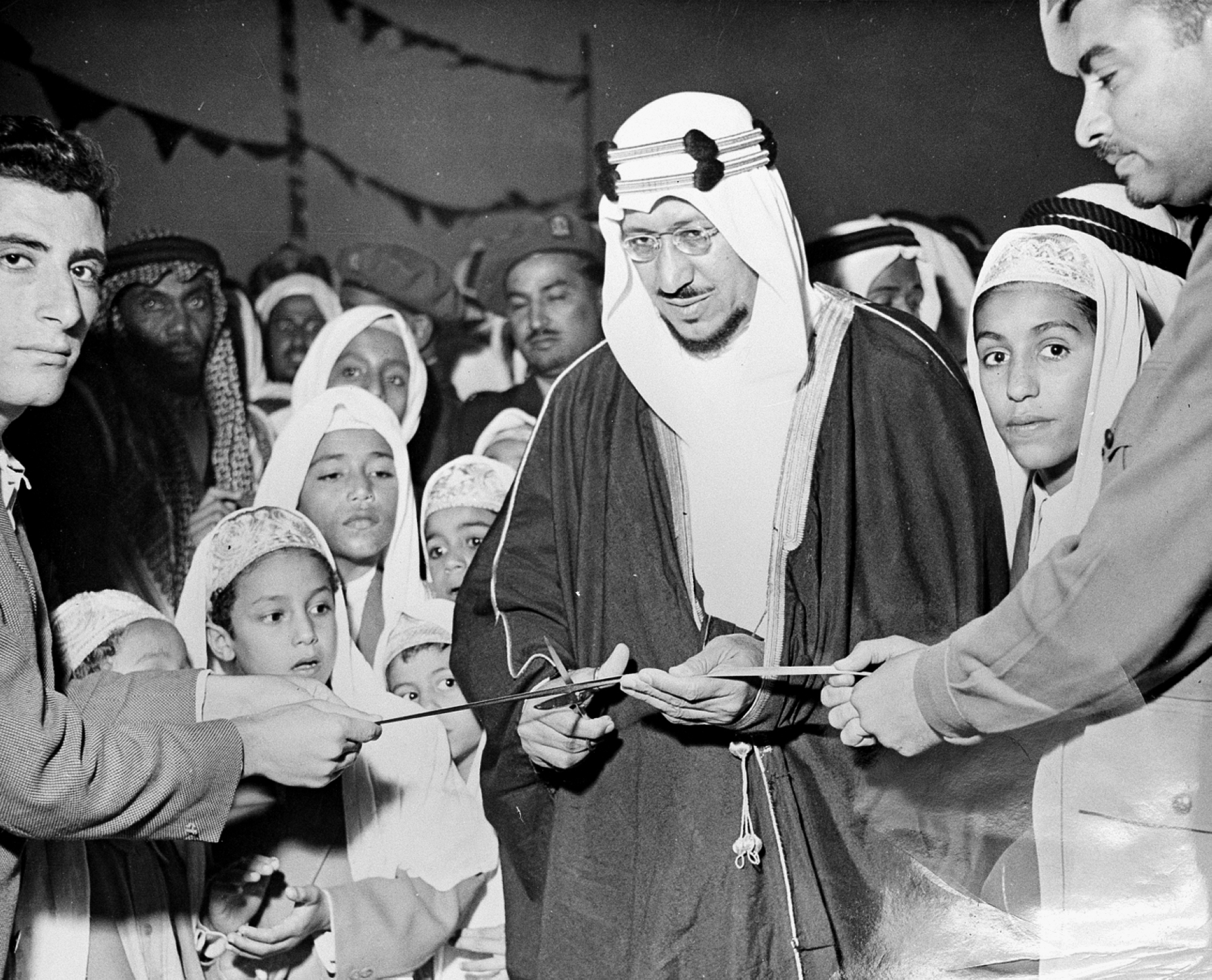
Attention to education
During King Saud's reign, education witnessed an advancement in several aspects, one of the most important being the establishment of the Ministry of Knowledge in 1953.
It is an extension of the previous Directorate of Knowledge, tasked with planning and supervising general education for boys in its three stages: primary, intermediate, and secondary. King Fahd was its first minister. The General Presidency for Girls' Education was established in 1960, and Sheikh Mohammed Bin Ibrahim Al Sheikh was chosen to supervise girls' education in the three stages: primary, intermediate, and secondary.
King Saud University was established in 1957, marking the true beginning of university education. It started with the College of Literature in 1953 and has since become one of the most important and largest universities in Saudi Arabia and the Middle East. The Islamic Univeity in al-Madinah al-Munawwarah was founded in 1961, beginning with the College of Sharia in the same year, expanding later to include religious and Arabic specializations. Imam Mohammed Bin Saud University was established, opening with the College of Sharia in Riyadh in 1953, followed by the College of Arabic Language the next year. The Higher Institute of Judiciary was established in 1965. These educational institutions formed the nucleus of Imam University, which was later inaugurated during the reign of King Faisal in 1974. The Institute of Public Administration was established in 1960 to meet the country's need for human resources capable of managing government agencies and contributing to administrative development. In addition, the establishment of 'Secondary Teachers Institutes' in 1961, following the role played by primary teachers’ institutes, arose from the growing need to elevate the education and readiness of graduates. The College of Petroleum and Minerals was established in 1963, later transforming into the University of Petroleum and Minerals in 1975. Its name was modified in 1997 to King Fahd University of Petroleum and Minerals.
Health services
King Saud directed the Ministry of Health to adopt a preventive health policy focused on health awareness and education. In line with this policy, he issued instructions for the establishment of a large quarantine center in Jeddah and the purchase of four mobile hospitals, costing SAR1.80,000, with an annual cost of SAR400,000. The purpose was to provide health and medical services to the residents of remote areas, given the difficulty of their access to fully equipped hospitals initially. Subsequently, hospitals were established throughout Saudi Arabia, with one of the most important being King Saud Hospital in Riyadh, inaugurated in 1956, with a capacity of fifty-four beds. At that time, it was considered one of the largest and most advanced hospitals. Additionally, the first sanatorium for tuberculosis and another for mental illnesses were established in Taif.
King Saud ordered the establishment of the Vocational Training Institute, and the first batch of students graduated in 1961. He also established the first school for nurses in 1960, linked to the General Presidency for Girls' Education. His attention to the health aspects of pilgrims led to the establishment of dedicated centers for them. During his reign, hospitals and medical clinics increased, and King Saud inaugurated al-Shumaisi Hospital in Riyadh in 1961. Medical treatment in hospitals became state-funded during his era. He also sent complete medical units with doctors, medications, and all necessary supplies to provide healthcare to the residents of remote areas, contributing to the service of citizens.
Developing the defense and aviation sector
King Saud worked to strengthen the Saudi army, enabling it to fulfill its role in protecting the nation, its resources, and its achievements, and achieving security and stability. In pursuit of this, King Saud utilized scientific means and modern methods, starting with the establishment of military schools in all regions of Saudi Arabia. These schools can be classified into two types: literacy schools for soldiers, established to eradicate illiteracy among soldiers and create military clerks for administrative tasks, and primary and secondary schools. There are a total of eighteen such schools throughout Saudi Arabia, allowing every individual to enroll. These schools feed students into the King Abdulaziz Military College in Riyadh, in addition to other secondary schools.
Specialized military schools, known as 'Army Schools,' were also established to prepare military personnel technically. In these schools, students receive training in various military disciplines such as infantry, artillery, armored vehicles, signals, physical education, maintenance, engineering, military police, nursing, and music. The establishment of King Abdulaziz Military College in Riyadh is considered a significant achievement during King Saud's reign. The college has graduated a large number of officers who have held important positions in the Saudi army. All instructors at the college were Saudi officers who received their military education abroad in the most prestigious military academies.
In order to establish a naval force to protect the extended coasts of Saudi Arabia in the east and west, the Ministry of Defense and Aviation established the Naval Forces Command. Naval missions were sent abroad for education in naval academies. Additionally, a naval institute was established in the city of Dammam at the beginning of 1957 to graduate naval officers and sailors for the naval forces. The creation of the 'Parachute and Aviation Corps' was another notable achievement, despite its recent establishment. Soldiers from the army bravely volunteered to join this corps, which was ordered to be created by the King in 1954.
To enhance the capabilities of Saudi military aircraft pilots, the Royal Saudi Air Force established specialized schools, including the Aviation School, Mechanical School, and Aeronautical Engineering School. The training of pilots was undertaken by Saudi experts who had studied at international aviation colleges. The Ministry of Defense and Aviation also sent military missions abroad for military studies and training. Additionally, the Ministry oversaw Saudi Arabian Airlines, which is considered the largest airline in the Middle East, providing services to citizens and pilgrims.
During the reign of King Saud, the Royal Saudi Air Force witnessed significant support, forming the nucleus of the first organized school for educating pilots and technicians in modern aviation sciences in Jeddah City. This was accompanied by ongoing scholarships for students to study aviation abroad. The Royal Air Force School was inaugurated on January 5, 1954. The Airport Operations School at Dhahran Airport, established in 1956, was transformed into a military school specializing in teaching the technical disciplines needed by the Royal Saudi Air Force. It was named the Royal Air Force Technical School in 1954. During this period, the first squadrons in the air force were formed, including the diverse first squadron and the first group consisting of transport and communication aircraft, such as the Dakota Skymaster, various training aircraft, and B-26 bombers, as well as military transport aircraft.
Additionally, the Transportation Squadron at Jeddah Air Base was equipped with aircraft of the 'Dakota' and 'C-254 Skymaster' models. In 1957, Saudi Arabia purchased 'Profid C13' aircraft. The 'B-26' Bomber Squadron formed the core of the third squadron at the Jeddah Air Force Base, known as the 'Bomber Squadron.' In furtherance of efforts to build the air force into a modern force, Saudi Arabia acquired twenty 'de Havilland Vampire' jet fighters to establish the fifth squadron, known as the 'Fighter Squadron.' The United States also agreed to provide Saudi Arabia with 'T-33' aircraft and a squadron of 'F-86' fighters. The Saudi government, in agreement with the United States, established a training facility at Dhahran Airport, forming the Combat Training Unit at Dhahran Airport. With the establishment of specialized squadrons, the Royal Saudi Air Force gained multiple airbases, paving the way for further development and modernization. King Saud inaugurated a munitions factory in al-Kharj on June 23, 1954, the first factory in Saudi Arabia dedicated to producing ammunition and light weapons. The construction of the factory was undertaken by a French company.
Culture and media
In 1955, King Saud issued a Royal Decree to establish the 'General Directorate of Radio, Press, and Publication,' which was divided into two sections: the Radio Section and the Press and Publication Section. Additionally, press offices were established in embassies and consulates, and a variety of bulletins, magazines, and books were regularly issued. The organization included an archive library, and a dedicated section for photography, advertising, and media. Regulations were also put in place to govern printing and publishing. Moreover, King Saud ordered the development of radio programming and increased the broadcasting power to enable it to fulfill its mission. As a result, the voice of Saudi Arabia was projected across the entire Middle East, adhering to principles of virtue, ethics, and the promotion of truth and justice.
King Saud also approved the establishment of television to showcase what is beneficial and useful, educating and enlightening the people with a new culture through exposure to the outside world. These media outlets broadcasted Hadiths, the Quran, religious sermons, and historical lectures about Islam and the Arab world. This significantly contributed to the intellectual, cultural, and emotional advancement of citizens, addressing social and cultural issues. King Saud laid the foundation stone for the grand radio project in Jeddah.
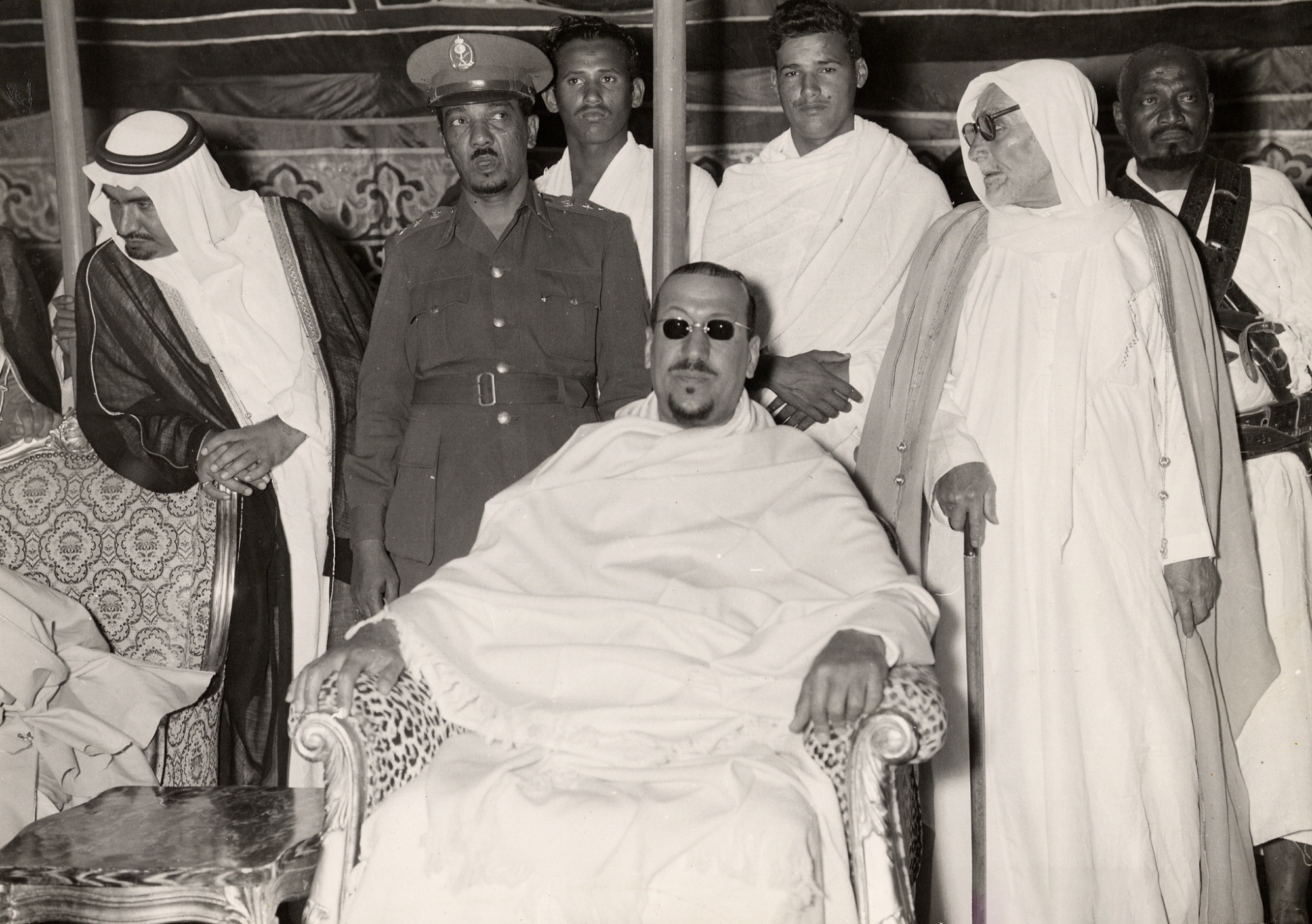
The architecture of the Two Holy Mosques and al-Kaaba's Kiswa
King Saud dedicated significant attention to the Two Holy Mosques during his reign, prioritizing the restoration of al-Kaaba al-Musharrafa and the expansion of the Holy Mosques. The restoration of al-Kaaba was the first since its reconstruction about three centuries ago. Additionally, during his era, the Kiswa was woven and embroidered in a dedicated factory established in Makkah al-Mukarramah. On April 5, 1956, King Saud laid the foundation stone for the expansion project of the Grand Mosque. A high committee, headed by Prince Faisal, then the crown prince, was assigned to oversee the project. The comprehensive expansion and construction of the Grand Mosque took place in three phases, involving the removal of nearby residential and commercial structures near the Mas'aa, the removal of buildings close to al-Marwa, the construction of an upper floor for the Mas'aa with a height of nine m, the erection of a vertical wall in two directions, and the allocation of a dual path. This path was designated for those using wheelchairs during their Sa'i, along with the installation of a barrier in the middle of the Mas'aa to divide it into two sections for the convenience of the pilgrims.
Sixteen gates were constructed on the eastern side of the Grand Mosque, from the side of Mas'aa, alongside a staircase featuring dual paths for Safa and Marwa. One path was dedicated to ascending while the other was for descending. Additionally, a channel with a width of five m and a height ranging between four and six m was established to redirect the course of the stream that used to cut through the Mas'aa and seep into the Grand Mosque. Moreover, the expansion extended to the area of Mataf, and staircases were constructed for Zamzam Well. The oval shape of Mataf used to cause congestion among the circumambulating pilgrims around al-Kaaba al-Musharrafa, and this was addressed by expanding the Mataf. The dome of Zamzam Well, previously used by the muezzins, was removed, and a dedicated building was constructed for them on the periphery of the Mataf. The open space of the Grand Mosque was also expanded, accommodating around four hundred thousand worshippers. This expansion encompassed the restoration of al-Kaaba al-Musharrafa and the enlargement of the Mataf, along with the renovation of Maqam Ibrahim (PBUH).
The expansion of the Prophet's Mosque coincided with that of the Holy Mosque during the reign of the Founder King. The three colonnades in the courtyard of the eastern, western, and northern mosques were removed, while the southern colonnade remained. Engineers, technicians, administrators, accountants, and workers were brought in for this project, along with modern machinery and equipment. A special office was established to manage and supervise this work. On November 30, 1952, King Saud (then Crown Prince) laid the cornerstone. On 11 Sha'ban of the same year, work began on excavating the foundations on the western side. In 1954, King Saud - when he was Crown Prince - personally undertook the construction of the Prophet's Mosque. He placed four stones in one corner of the western wall in commemoration of the Prophet Muhammed - peace be upon him - and inscribed the date of their construction on these stones. In this expansion, streets were opened, and squares were planned to serve as connection, distribution, and service areas for the Prophet's Mosque. There were six main streets and an expansion of three streets. As for the squares established around the Prophet's Mosque, they are: Bab al-Salam Square, Bab al-Majidi Square, and Jibril Gate Square on the eastern side.
King Saud inaugurated the expansion in October 1955 in the presence of delegations from Arab and Islamic countries, along with several scholars and ministers. The expansion was located on the western side of the Prophet's Mosque, and King Saud personally inaugurated the Saudi Gate of the Prophet's Mosque.
Judicial regulation
As part of King Saud's efforts to safeguard rights, achieve justice, and establish judicial regulation, the 'Board of Grievances' was established in 1954. Initially, it functioned as a general administration within the Council of Ministers and gained independence from the Council of Ministers on May 9, 1955. The board worked on implementing all laws and regulations issued by the authorities, and its responsibilities included adjudicating lawsuits brought before it, combating bribery, deciding on the execution of judicial judgments issued by Arab countries' courts, and participating in disciplinary councils for employees of the second rank and above, excluding ministers. It operated alongside the Sharia judiciary and its various structures.
Organization of state agencies
During that period, the state apparatus was known as the 'Board of Employees,' 'General Auditing Bureau', and 'Board of Grievances'. The Board of Employees was established during the reign of King Abdulaziz, but its role and regulations were only activated during the era of King Saud. It gained particular importance after a decision by the Council of Ministers in 1954 to transfer the Board of Employees from the Ministry of Finance and attach it to the Presidency of the Council of Ministers. This bureau became responsible for monitoring the implementation of laws and instructions related to employees' affairs. It marked the first time in administrative regulation history that the Board of Employees became the authority in charge of employee affairs.
The General Auditing Bureau was established during the reign of King Saud by Royal Decree in 1954. Its purpose was to audit all state accounts and verify the accuracy of revenue and expenditure records in all ministries and departments funded by the state. The head of this division is the 'General State Auditor,' appointed by Royal Decree. The General State Auditor is fully responsible before the king and serves as the primary authority in this regard.
Aspects of the biography of King Saud Bin Abdulaziz
King Saud's humanity
King Saud was renowned for his significant humanitarian efforts across various avenues of charity, especially in initiatives that benefited members of Saudi society. He was keen on listening to people's complaints, inspecting their conditions, and responding to their requests. His assistance was not limited to the Saudi population alone but extended to encompass all Arabs. He supported various organizations and institutions dedicated to serving Palestinian refugees and addressing their needs. Additionally, he sponsored mobile hospitals that traveled throughout Saudi Arabia, covering the costs from his personal account, including the salaries of physicians, nurses, medications, and maintenance.
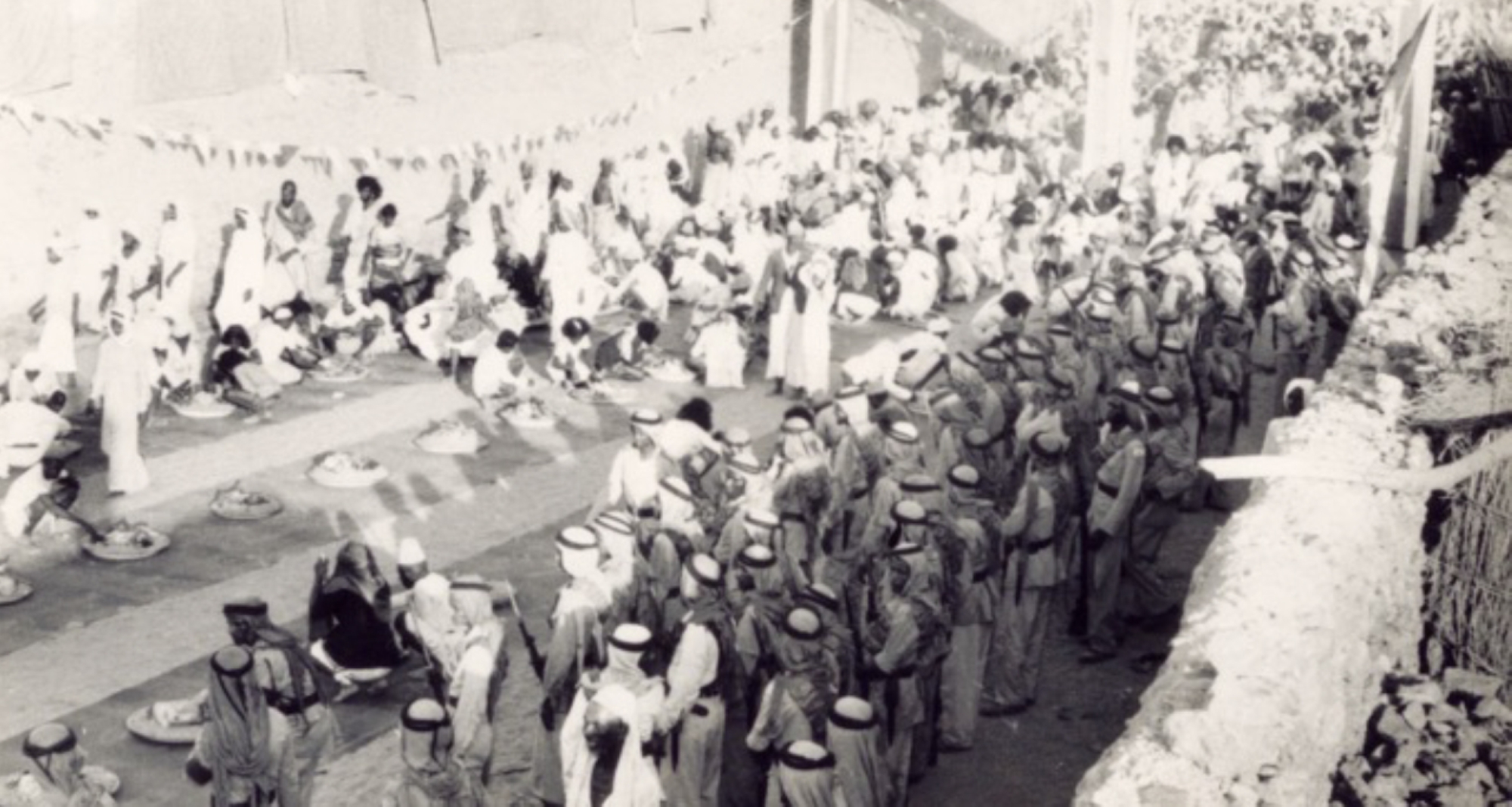
King Saud also took on the responsibility of repaying housing and agricultural loans for poor farmers, which amounted to over SAR4 million according to available data. In al-Madinah al-Munawwarah and al-Bukayriyyah Governorate, he exempted farmers from their loans. In the Eastern Province, al-Ahsa, and al-Qatif, he personally paid SAR2.5 million to support farmers. Additionally, he focused on the construction and restoration of mosques. In Hejaz, he built 195 mosques for SAR3.5 million. Hundreds of mosques were constructed across Saudi Arabia. He also established religious educational institutes where students received special stipends to encourage religious studies. Furthermore, King Saud incentivized the memorization of the Quran by offering generous financial rewards.
The death of King Saud Bin Abdulaziz
King Saud passed away in Athens, the capital of Greece, in 1969. His body was transported to Makkah al-Mukarramah, where funeral prayers were performed in the Grand Mosque, and he was laid to rest in al-Oud Cemetery in Riyadh.
Entities bearing the name of King Saud Bin Abdulaziz
King Saud Bin Abdulaziz University for Health Sciences.
King Saud Public Library.
Related quizzes
Related articles


